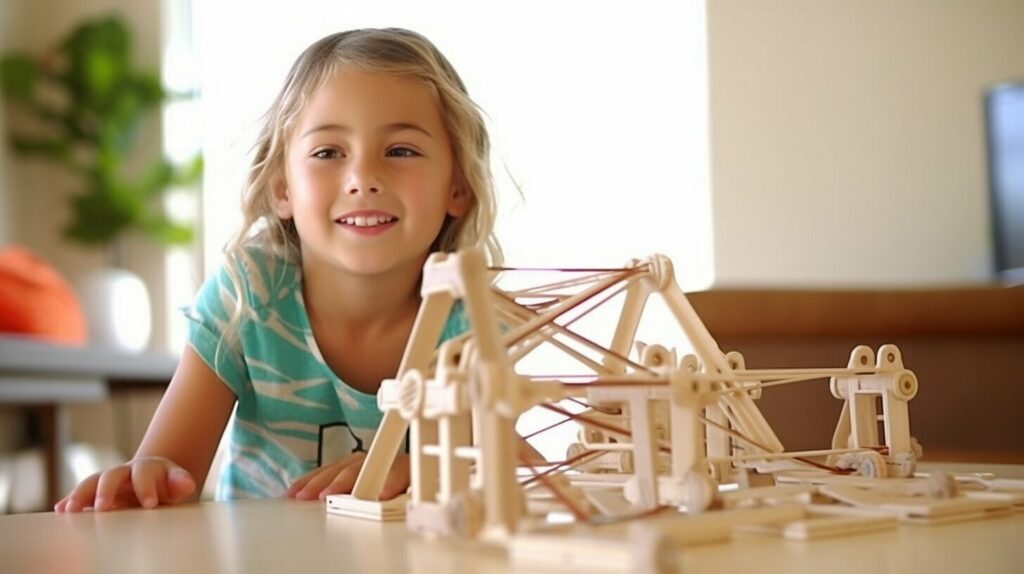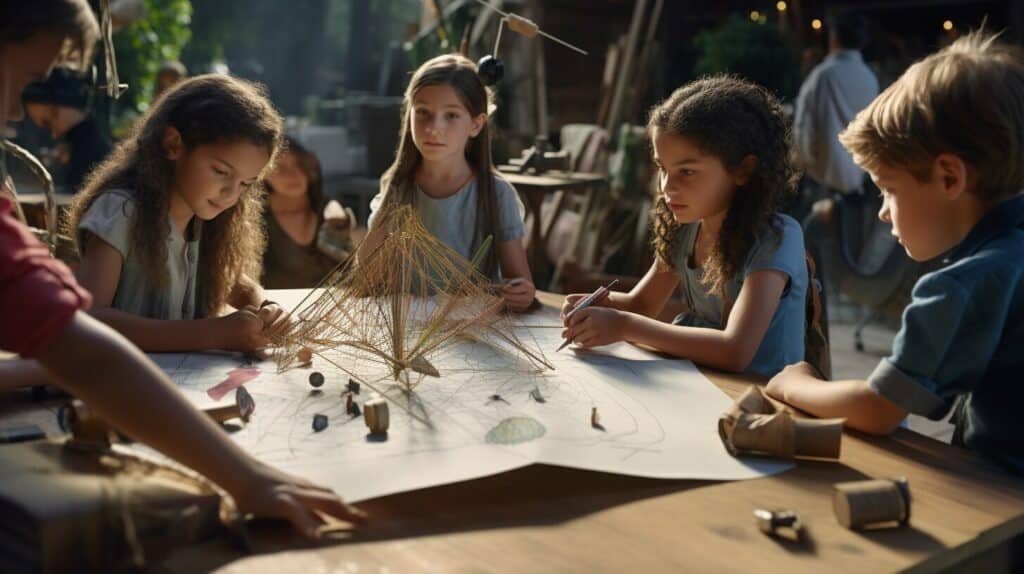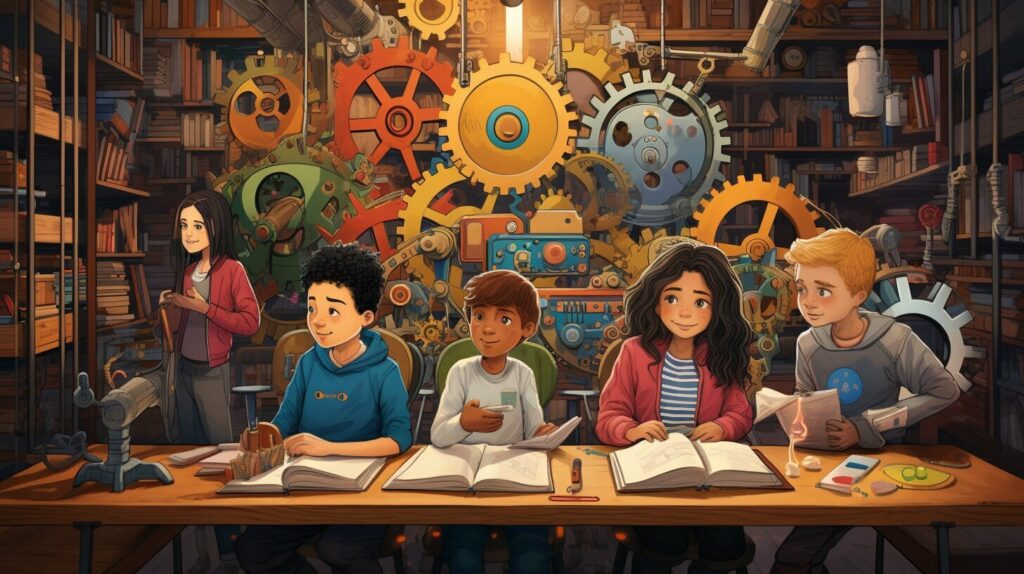Are you struggling to explain engineering concepts to your child? Do you want to spark their interest in this exciting field? Look no further, because in this section, we will explore fun and easy techniques for explaining engineering to children.
By using simple language and engaging activities, you can make engineering accessible and enjoyable for your child. So, let’s dive in and discover how to make engineering fun!
Key Takeaways:
- Explaining engineering to a child can be done through fun and easy techniques.
- Using simple language and engaging activities can make engineering accessible to children.
- By sparking their curiosity, you can ignite their passion for this exciting field.
Why Introduce Engineering to Kids?
Engineering may seem like a complex field, but introducing it to kids has numerous benefits. By exposing children to engineering concepts at a young age, they can develop problem-solving skills, critical thinking abilities, and creativity. Early exposure can also inspire them to consider a career in engineering as they grow older.
When kids learn engineering concepts, they gain real-world knowledge that they can apply to their everyday lives. They’ll learn about simple machines, how things work, and how to solve problems. They’ll understand that engineering plays a significant role in nearly every aspect of our lives, from the bridges we cross to the smartphones we use.
Teaching engineering to young children also boosts their confidence and self-esteem. When they tackle engineering challenges and succeed, they feel a sense of satisfaction and accomplishment that can carry over into other areas of their lives.
Overall, introducing engineering to kids can help prepare them for a bright future and open up a world of possibilities.

Simplifying Engineering Concepts
Explaining engineering to a child can be challenging, especially since many engineering concepts can be complex and abstract. However, by simplifying these concepts, you can help your child grasp them more easily.
One way to break down engineering concepts is to use analogies that your child can relate to. For example, you can explain how a suspension bridge works by comparing it to a see-saw. Just as weight distribution is crucial for a see-saw to work properly, a suspension bridge relies on evenly distributed weight to stay balanced.
| Tip: | Use examples from your child’s daily life to illustrate engineering concepts. For example, you can explain how a zipper works by showing them their own jacket or backpack. |
|---|
Another effective way to simplify engineering concepts is to use visuals such as diagrams or animations. These can help your child visualize how a machine or structure works and understand the various components that make it up. For example, you can show them a diagram of a simple machine like a lever and explain how it works in a way that they can understand.
You can also use hands-on activities to give your child a practical understanding of engineering concepts. For example, you can build simple machines with household items and explain the principles behind them as you work. This hands-on approach can help your child see how engineering concepts apply in the real world and make them more tangible and accessible.

Remember to keep your explanations simple and straightforward, and use language that your child can understand. Using analogies, visuals, and hands-on activities can make engineering concepts more accessible and interesting to your child, and help them develop a lifelong passion for this exciting field.
Engaging Activities and Experiments
Explaining engineering to kids can be challenging, but hands-on activities and experiments can make the learning process fun and engaging. Here are some easy activities you can try:
| Activity | Description |
|---|---|
| Bridge building | Using materials such as popsicle sticks, straws, and tape, kids can design and build their own bridges to test their strength and stability. |
| Electric circuits | With a simple electrical circuit kit, kids can learn about conductivity and create their own working circuits. |
| Egg drop | Challenge kids to design a container that will protect a raw egg from breaking when dropped from a height. This activity teaches the principles of impact resistance. |
These activities not only teach engineering principles, but also promote teamwork and problem-solving skills. Plus, they are a lot of fun!

“Children are born scientists, curious about the world around them. Engaging them with hands-on activities allows them to explore and learn in a way that comes naturally to them.”
Storytelling and Books
Storytelling is a powerful way to introduce engineering concepts to children. By incorporating age-appropriate books into your teaching, you can capture their imagination, make learning fun, and provide them with a unique perspective on the field.
Consider reading books like “Rosie Revere, Engineer” by Andrea Beaty or “The Most Magnificent Thing” by Ashley Spires. These stories use relatable characters and captivating illustrations to break down complex engineering concepts into simple and relatable terms.
Another excellent resource is “The Way Things Work” by David Macaulay. This book uses illustrations and clear explanations to explore the inner workings of machinery, from simple pulleys to complex computers.
Don’t miss the opportunity to use storytelling as a tool to inspire children to pursue engineering.

Visual Aids and Illustrations
To enhance a child’s understanding of engineering concepts, visual aids and illustrations can be incredibly useful. By using diagrams, infographics, and other visual tools, you can help children grasp complex concepts in a clear and engaging manner.
One effective way to use visual aids is to show how things work. For example, use diagrams to break down the inner workings of a machine and explain how each component contributes to the overall function. You can also use infographics to illustrate complex processes and equations.
Another approach is to use illustrations to make abstract concepts more tangible. Drawings and animations can help children visualize how forces and other physical phenomena work, making them easier to understand.
When using visual aids and illustrations, make sure they are age-appropriate and relevant to the topic at hand. Choosing the right visuals can make all the difference in helping a child develop a firm understanding of engineering concepts.

Field Trips and Guest Speakers
Field trips and guest speakers are excellent ways to expose children to real-world examples of engineering. Taking children on a field trip to a science museum or a construction site can provide them with a firsthand look at the world of engineering. It’s an opportunity for children to see how the concepts they are learning in the classroom are being applied in the real world.
Inviting engineers to speak to children about their work is another way to pique their interest in engineering. Engineers can share their experiences, explain how they solve problems, and answer questions that children may have about the field. Having a guest speaker in the classroom can make the learning experience more interactive and engaging, and can help children see the relevance of engineering to their daily lives.

When organizing a field trip or inviting a guest speaker, it’s important to consider the age and interests of the children. Choose a location or speaker that is relevant to their age group and that will capture their attention. Encourage children to ask questions and participate in discussions to make the experience more interactive.
Field Trip Ideas
Here are some field trip ideas that can help children explore the world of engineering:
- Science museums with interactive exhibits related to engineering, such as robotics or transportation displays
- Construction sites to see how buildings, bridges, and other structures are designed and built
- Manufacturing plants to learn about the process of creating products and how machines and technology are used
- Aerospace centers to explore the science and engineering behind space exploration
Field trips can provide children with a unique perspective on the world of engineering, and can inspire them to pursue the field as they grow older. By introducing them to the possibilities in engineering, you can help them develop a passion for this exciting and rewarding career path.
Incorporating Technology and Engineering Toys
Children love playing with toys and technology, making them an excellent way to introduce engineering concepts to kids. By incorporating engineering toys and technology, you can make learning about engineering more fun and interactive.
You can start by introducing your child to building sets like Legos, K’NEX, or Tinkertoys. These toys allow children to build and explore engineering concepts, such as structure, balance, and design.
You can also incorporate technology into your explanations. For example, you can show your child videos of engineering projects or use educational engineering apps. By using technology, kids can see firsthand how engineering concepts are applied in real-life situations.

Another fun way to incorporate technology is by using programmable robots like Wonder Workshop’s Dash and Dot or Lego’s WeDo. These robots allow children to learn programming and robotics while also exploring engineering concepts like mechanics and motion.
Remember that the goal is to make learning about engineering fun and engaging for kids. By incorporating technology and engineering toys, you can make the learning process more interactive and enjoyable while also promoting STEM education.
Encouraging Problem-Solving and Critical Thinking
Problem-solving and critical thinking are key skills in engineering. As you explain engineering concepts to your child, it’s important to encourage them to think critically and come up with solutions to problems. One way to do this is through engineering-related challenges and puzzles.
You can find many age-appropriate engineering puzzles and games online or in stores. For example, you can challenge your child to build a tower using only marshmallows and toothpicks, or ask them to design a bridge that can hold a certain amount of weight using only popsicle sticks.
Another way to encourage problem-solving and critical thinking is to give your child open-ended questions that require them to use their creativity and imagination. For example, you can ask them how they would design a roller coaster or a robot that can help with household chores. This will get them thinking about how engineering can solve real-world problems.

By encouraging your child’s problem-solving abilities and critical thinking skills, you’ll not only improve their understanding of engineering but also enhance their overall cognitive development. So don’t be afraid to challenge them and let them come up with their own solutions!
Inspiring Creativity and Innovation
Engineering is not just about following rules and formulas; it’s about thinking creatively and innovatively to come up with solutions to complex problems. By encouraging your child’s creativity and imagination, you can help them develop a true passion for engineering.
One way to inspire creativity is to encourage your child to think outside the box when approaching engineering challenges. Teach them to look for unconventional solutions and to see problems from different perspectives.
You can also introduce your child to historical engineering achievements and the people behind them. Show them how these engineers thought creatively and innovatively to solve problems and change the world.

Finally, consider giving your child access to engineering toys that encourage creativity and innovation. These toys can range from simple building blocks to advanced robotics kits. By letting your child experiment and explore with these toys, you can nurture their natural curiosity and help them develop a love for engineering.
Conclusion
Exploring the world of engineering with children can be a rewarding and exciting experience. By using the fun and easy techniques we’ve discussed, you can introduce your young ones to the fascinating world of engineering concepts.
Don’t hesitate to simplify engineering concepts to make them more accessible to your kids. Engage them in activities and experiments that help them grasp engineering principles in simple terms. Use storytelling and age-appropriate books to capture their imagination and make learning about engineering a fun and memorable experience.
Incorporating technology and engineering toys, taking field trips, and inviting guest speakers can also expose kids to real-world examples of engineering in action. Encouraging problem-solving and critical thinking skills through engineering-related challenges and puzzles can develop cognitive abilities and enhance your children’s understanding of engineering.
Most importantly, inspire creativity and innovation in your children. Nurturing their innovative thinking can help them develop a true passion for engineering and, who knows, they may even consider a career in engineering as they grow older.
Start exploring these techniques today and watch as your children’s love for engineering blossoms!
Can I Use Metaphors to Explain Engineering to a Child as Well?
Explaining engineering concepts to children can be challenging, but incorporating soccer metaphors for explaining to children can make it easier. Just like in soccer, where players coordinate their movements to achieve a goal, engineers work together to create innovative solutions. By comparing engineering principles to soccer tactics, children can grasp the complexities of the field and understand the teamwork involved in this exciting field.
FAQ
Q: How can I explain engineering to a child in a fun and easy way?
A: Explaining engineering to a child can be made fun and easy by using simple language and engaging activities. By breaking down complex concepts into bite-sized pieces and incorporating hands-on experiments, you can spark their curiosity and make learning about engineering an enjoyable experience.
Q: Why is it important to introduce engineering to kids?
A: Introducing engineering concepts to kids at a young age can help develop their problem-solving skills, critical thinking abilities, and creativity. This early exposure can also inspire them to consider a career in engineering as they grow older, opening up a world of possibilities for their future.
Q: How can I simplify engineering concepts for children?
A: Engineering concepts can seem complex, but by simplifying them, you can make them more accessible to children. Strategies such as breaking down concepts into smaller parts, using analogies and real-life examples, and providing hands-on experiences can help children understand and grasp the fundamentals of engineering.
Q: What are some engaging activities and experiments to explain engineering to kids?
A: Engaging children in hands-on activities and experiments is a great way to explain engineering principles. Activities such as building bridges, creating simple machines, and designing paper airplanes can help kids explore engineering concepts in a fun and interactive way.
Q: How can storytelling and books be used to explain engineering to kids?
A: Storytelling and age-appropriate books can be powerful tools for introducing engineering concepts to kids. By weaving engineering principles into stories and reading books that showcase engineering achievements and challenges, children can easily relate to and understand the world of engineering.
Q: How can visual aids and illustrations enhance a child’s understanding of engineering?
A: Visual aids and illustrations can complement verbal explanations and help children visualize engineering concepts. By using diagrams, infographics, and other visual tools, you can make complex ideas more accessible and engaging for young learners.
Q: How can field trips and guest speakers contribute to understanding engineering for kids?
A: Taking children on field trips to engineering-related places and inviting guest speakers, such as engineers, can provide real-world examples and insights into engineering. Exposing children to these experiences can help them see how engineering is applied in the real world and inspire their interest and curiosity.
Q: How can I incorporate technology and engineering toys to teach kids about engineering?
A: Children are often drawn to technology and toys, making them excellent tools for teaching engineering. By using educational engineering toys and incorporating technology such as coding or robotics, you can make the learning process interactive and enjoyable for kids.
Q: How can I encourage problem-solving and critical thinking in kids through engineering?
A: Problem-solving and critical thinking are vital skills in engineering. You can encourage these skills in children by presenting them with engineering-related challenges and puzzles. By giving them the opportunity to think critically and solve problems, you can enhance their understanding of engineering and develop valuable cognitive abilities.
Q: How can I inspire creativity and innovation in kids through engineering?
A: Engineering is all about creativity and innovation. To inspire these qualities in children, you can encourage them to think outside the box when approaching engineering problems. By providing open-ended projects and fostering an environment that values creative thinking, you can help children develop a true passion for engineering.






